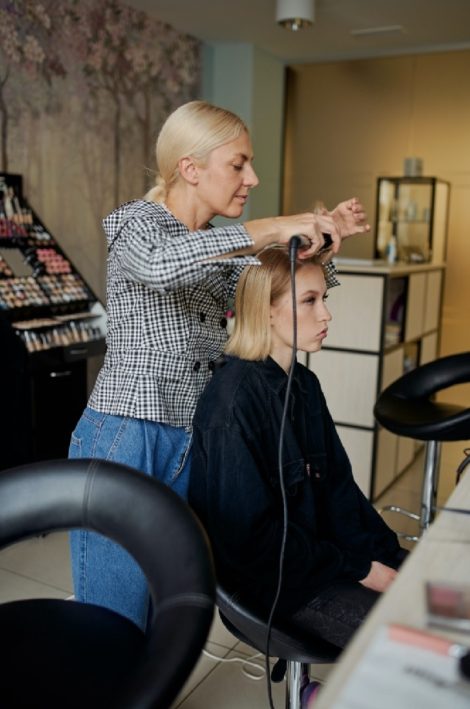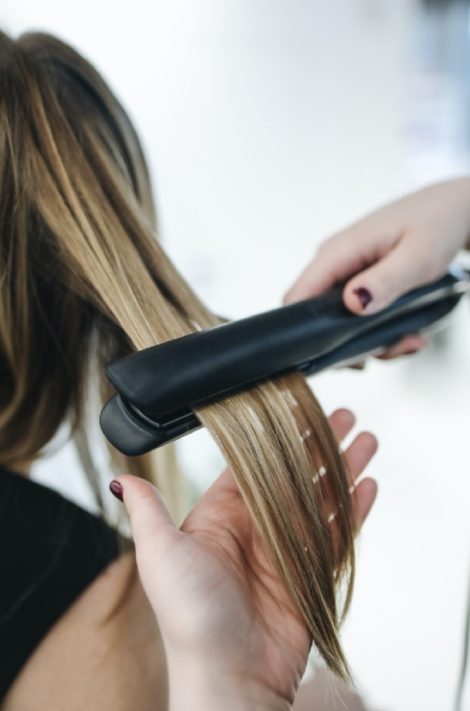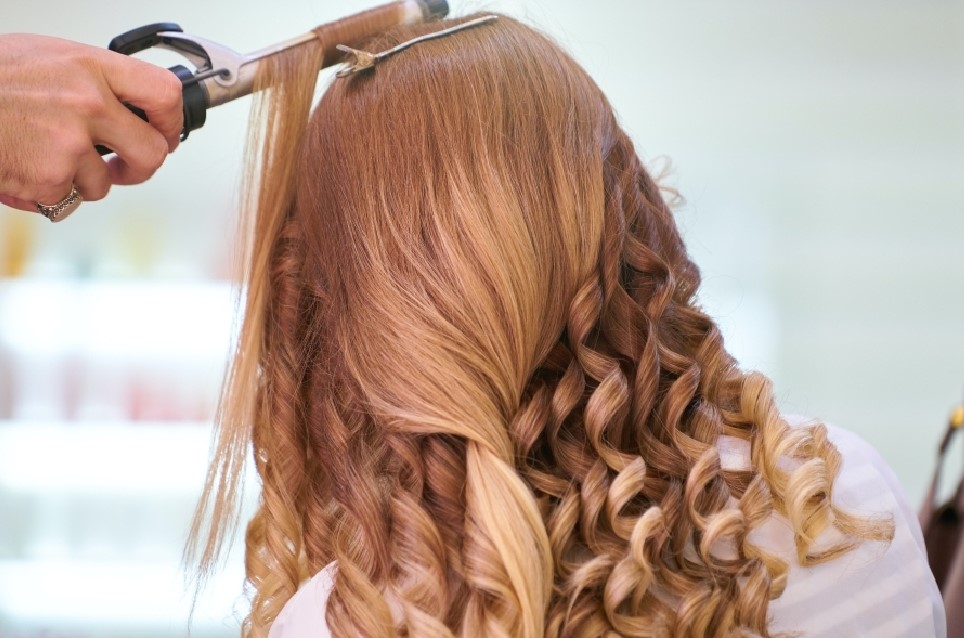What Is heat-damaged hair?
How often should you wash damaged hair?
What causes heat-damaged hair?
Can you repair heat-damaged hair?
How to treat heat-damaged hair at home?
Can heat-damaged hair grow?
What is chemically damaged hair?
In this era, it is almost impossible to have a hairstyle done without using a heat tool. I am one of the guilty ones because heating products help your hairstyle look professional and last longer. Not to mention the fact that you can change the texture of your hair by curling it, straightening it, or even making it look wavy. Sadly, with all this heat use comes the damage. In more cases than not, damage to the hair is permanent. But, how can you tell that your hair is heat damaged? What does heat-damaged hair even look like?
In this article below, we will discuss this topic and go into a little more depth. But one thing to keep in mind never forgets to wear a Mane Caper’s kid’s cape or a Mane Caper apron while doing anything with hair.

What Is Heat-Damaged Hair?
Before we get into the details, it is essential to know what heat-damaged hair even is. If you know what heat-damaged hair looks like, the first step in repairing your hair is already done.
When you straighten your hair completely, heat-damaged hair looks dry and brittle. As the natural proteins of your hair are gone, the appearance of your split ends is more exaggerated, and the hair doesn’t fall flat. Heat tools basically dry out the cuticles of your hair and therefore change the hair protein structure. The hair also has a rough and stringy texture, making it difficult to comb, resulting in tangles, knots, and breakage. Sometimes, it can also cause discoloration of hair, especially in colored hair. All of these are common characteristics of heat-damaged hair.
How Often Should You Wash Damaged Hair?
Now that you know what heat-damaged hair looks like, the next important question is how often should you even wash damaged hair? Doesn’t washing hair too often dry them?
Washing too often with harsh shampoos can indeed cause hair to get dry and damaged, so it is recommended to wash your hair once it feels oily. Notice that straight and thin hair gets oily quickly and needs to be washed more often than curly or wavy hair. Regardless of hair type, it is suggested that you should wash damaged hair every 5 to 7 days to allow some natural oils to decrease the dryness. Especially because shampoos often cause dry hair by stripping the natural hair oils too harshly. Moreover, the weather affects how often you should wash your hair as well.

What Causes Heat-Damaged Hair?
Tell me, what is the use of all the previous information if you do not know the causes of heat damage? You might be able to fix the damage, but you are prone to repeating the same mistakes again.
As the title suggests, heat is the main culprit behind heat-damaged hair. Heating tools like hairdryers, hair straighteners, and curling irons all have temperatures between 158°F to 482°F. This heat is enough to cause the hair to lose its elasticity, flexibility and increase friction. The higher the temperature of your heating tool, the worse the damage as it changes the hair protein structure both mechanically and physically. Moreover, heat damage isn’t caused only by heating tools; in fact, the sun can cause heat damage.
Can You Repair Heat-Damaged Hair?
Now that you know almost all the basics about heat-damaged hair, you must be wondering, but is there a way to repair heat-damaged hair? Is the only solution chopping the hair that you grew with so much love?
The first thing that you should do is stop using heat immediately. And when you need to use heat, make sure to use a heat protector containing silicones. Remember, heat damage on different hair types has different effects, so different ways to repair them, but some ways you can restore your hair without chopping them off are listed below.
- Curly hair: Curly hair needs to restore moisture back into hair follicles. Therefore, hair masks and deep-conditioning is essential. Ingredients like shea butter, argan oil, aloe vera, coconut oil, and avocado are good homemade remedies.
- Straight hair: For straight hair, split ends are the main problem, so you need to restore its natural proteins. Leave-in protein treatments and conditioning spray rich in keratin can be useful to restore the natural bonds. Home-made remedies containing olive oil, honey, and yogurt can be helpful as well.
- Colored hair: This includes any chemically treated hair like bleach or perm. This usually requires professional assistance like a hair mask and deep-conditioning from the salon. At home, you can try hot oil treatments.
- For all hair: You can do some things at home regardless of the hair texture or type. Such as using natural shampoo, Epsom salt, and a cool-mist humidifier.

How to Treat Heat-Damaged Hair at Home?
I have already mentioned some of the home remedies that may help repair damage caused by heat at home. But now, I will go a little more in-depth here.
- Oil soak: For dry and damaged hair, you can use coconut oil, Ucuuba butter, and olive oil. Firstly, for an oil soak, you need to massage your head with the oil for 15 to 20 minutes, then cover the hair with a towel soaked in hot water, and leave it on for an hour before washing it.
- Hair mask: Hair masks are very easy to make at home and usually only use simple ingredients. Some of the hair masks that you can make are banana and olive oil masks, egg and yogurt masks, avocado and olive oil masks, and honey and oil masks. All of these need to be applied for 15 to 30 minutes.
- Tea wash: Not as crazy as it sounds and can be pretty soothing. All you need are tea leaves. You need to boil tea leaves, let them steep for 30 minutes, and use that water after shampooing. Make sure to use it on wet hair and wash with cold water after 15 minutes.
- Egg: It is a common fact that egg contains a lot of protein. You can use it as a hair mask or even mix it with shampoo to use on hair for 5 minutes before rinsing.

Can Heat-Damaged Hair Grow?
What if you love long hair, but unfortunately, your hair has just been diagnosed with heat damage! Oh no, what now? Should you just cut it and start over? Or let it grow? Can heat-damaged hair even grow?
If home remedies and other treatments work, then there is no need to cut your damaged hair. And damaged hair can still grow as long as you take care of it using hydrating treatments, keratin-infused products, and have patience. The first step to growing your hair out is to cut them! Only the ends, though, as it will, in turn, help your hair grow faster. Moreover, you need to stop using heat, eat healthily, and wash your hair less frequently.
What Is Chemically Damaged Hair?
One thing that might go hand in hand with heat-damaged hair is chemically damaged hair. But what even is chemically damaged hair? Is it the same as heat damage?
When chemicals damage the outer hair cuticle and enter the inner part, which causes split ends, hair breaking, and unhealthy hair, just like heat damaged hair is chemically damaged hair. Chemicals like hair color, bleach, perms, and hair relaxant are the reasons behind this damage. But, this can also be fixed with care, just like heat damage can.
In the end, all you need is a little love and patience to fix and take care of your hair. Hair is an essential part of your body; it not only enhances your look but also protects your body! Therefore, return the care that is bestowed upon you as well.
Lastly, check out our Mane caper ¾ sleeve jacket, a fashion statement, and other pieces from the Mane Caper shop.

